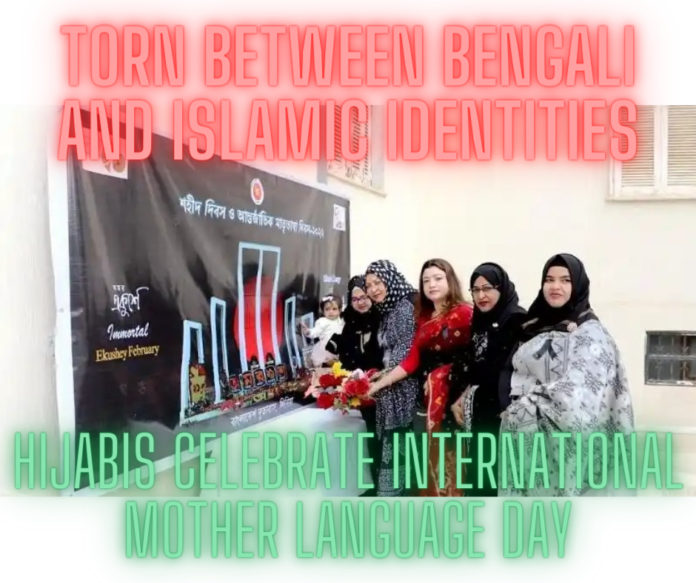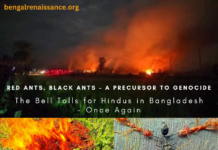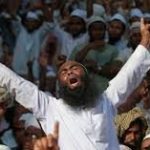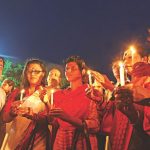Legendary Bengali novelist Sarat Chandra Chattopadhyay sets the context in this regard when he remarks in one of his famous literary works,‘Srikanta’, “The Bengali and Musalman (Muslim) students were playing a football match in the school playground.” The essence of being a Bengali comes loaded with an age-old cultural and religious connotation rooted in Bengal which predates the advent of Islam in Indian subcontinent. This is diametrically opposite to the ‘Bengali’ identity which is being claimed by the Muslim intellectuals in Bangladesh and India, who happen to speak a certain dialect of Bengali by chance. The concept of “Bengali” for the Muslims is more of a geographical identity marker and a strategic tool devoid of the quintessential socio-cultural and religious core.
Islam in general, disapproves any religio-ethnic identity which clashes with its concept of Ummah or Islamic brotherhood. However, a geographical identity is allowed and practiced. For example, a notorious Islamic State operative caught in Bengal was named as Abu Al-Musa Al-Bangali. Here ‘Bangali’ is merely a geographical identity marker rather than an ethnic or religious identity per se.
For starters, Muslims cannot write their name in Bengali. The so-called ‘greatest Bengali of 1000 years’ as claimed by a BBC survey is called ‘Sheikh Mujibar Rahman’, none of the three words are a part of the Bengali lexicon but borrowed from Arabic. They are Bengali in alphabet perhaps but not in essence. Aliah University, a government funded Islamic university in West Bengal has on its logo a date tree, a plant native to the Arabian desert and a cultural symbol in Arabic countries, but has no special significance in Bengal.
Bengali identity is also a tool of convenience for the Muslims. The ‘1971 War Of Independence’ is popularly touted as a language movement but was a battle of resources with the West Pakistanis who were milking the region dry of its resources without an iota of development, the same problem which Balochistan is now facing. Another cause of heartburn of the ‘Bengali Muslims ‘ for the Urdu Imposition was the loss of white collar jobs to the West Pakistan counterparts rather than a love of the language. Ironically the proponent of the language movement was Constituent Assembly member and martyr Dhirendranath Dutta, a quintessential son of the soil who did not even get a fraction of recognition accorded to Rafique, Jabbar and others who are a part of the Bangladesh folklore.
Post independence, Bengali identity was a tool of legitimacy for the young nation suffering from Identity crisis but not able to fully adopt the rooted social, religious and cultural identity which is inimical to the dominant Islamic identity. One ridiculous idea proposed was that the Bengali New Year was proposed by the Mughal Emperor Akbar, whereas in reality it was initiated by Shashanka, the King of Gauda. However the Bengali identity can be strategically dropped as a matter of convenience by the Muslims when some objectives are to be fulfilled.
In the highest traditions of Al Taqiyaa or ‘the art of deception’, the Bengali Muslims turned against their co-linguists in favour of the Assamese chauvinists during the Bengali Language Movement of Assam in 1961. On 19th June, thousands of riotous Bengali Muslim mobs descended in Hailakandi, shouting slogans like ‘Allah Hu Akbar’, ‘Chaliha Sarkar Zindabad’ (Long Live Chaliha Government) and ‘Asomiya Bhasha Sikhte Hobe’ (Learning Assamese is a must). The mother of all ironies is that all the slogans were given in Bengali.
The foundation of the core identity of an ethno-linguistic group is formed on the basis of the achievements of its illustrious members. While illustrious sons and daughters of Bengal have marked their achievements at the world or national stage in plenty, the fact that they were Hindus and were culturally rooted is a great cause of inferiority complex for the Islamists trying to assert a nouveau-Bengali Identity. The handful they can muster comes with a rider, they are from the politically dominant Ashraf community (upper strata of the Muslim society) and claim their genealogy to the Middle-East or other provinces of India. In short none of their ancestors were ethnic Bengalis. It’s like playing a derby match with foreign players, since locals are not good enough.
Let us consider the case of poet and lyricist Kazi Nazrul Islam, touted as the Islamic Bengal’s answer to Nobel-Laurate Rabindranath Tagore. Literary achievements apart, ethnically he is not a Bengali in the first place. His ancestors trace their origin in Hajipur, in Patna, modern day Bihar and migrated in Asansol region of West Bengal, only in the eighteenth century during the reign of Shah Alam. Another discrepancy comes from the literary works of the poet himself. He wrote, “Bangalir Khoon e Laal holo jetha Cliver Khanjar.” (Where [Robert] Clive’s sword got stained in Bengali blood). This has reference to the Battle of Plassey, fought between Nawab Siraj-Ud-Daulah and Robert Clive of East India Company. The first note of discrepancy in this is the fact that Siraj is called a ‘Bengali’. Siraj and Alivardi Khan were of Turkic origin and migrant regents of the Mughal emperor. They could not even speak the language in the first place. Another point is the use of the word khoon and Khanjar. Khoon in Bengali means ‘murder’ but in Urdu (from Persian) it means blood. Here khoon is used to denote blood , thus a Urdu word is used in a Bengali context. Secondly khanjar meaning dagger, is again a Urdu (from Persian) word and not from the Bengali lexicon.
While thousands of Bengali Hindu revolutionaries have sacrificed themselves to liberate India from the clutches of the British, the question of a single Bengali Muslim revolutionary is greeted with vacuum and stony silence. In order to make up for the shortfall, Marxist historians have discovered a 19th century Muslim zealot, named Mir Nisar Ali, popularly known as Titumir and rebranded him as a ‘freedom-fighter’. To begin with Titumir’s Family claimed Arab ancestry, thus he is not a ethnic Bengali in the first place. In action, he was diametrically opposite to anything remotely Bengali. His animosity was mostly against the predominant religion and cultural essence of Bengal, which we wanted to replace with a Salafist culture, imported from Hejaz (present day Saudi Arabia). At that time many local Muslim converts whore dhoti, a traditional Bengali attire. He prohibited Muslims from wearing the dhoti (since it was associated with Hindus), and enjoined them to wear a tahband (piece of cloth wrapped around the waist) over their lungis. He also enforced the Islamic code of keeping beards without moustache and made it mandatory for women to wear the burqa, which was hitherto alien in Bengali society.
Coming back to the BBC nominated “Greatest Bengali of 1000 years”, Sheikh Mujibur Rahman, tracing back to his family tree, his ancestor was a 15th century Middle Eastern immigrant who claimed Iraqi ancestry and settled in Chittagong to preach Islam .Though Sheikh Mujibur Rahman’s claim to fame was facilitated by toying with Bengali Language Movement, in practice he was originally in favour of integrity of Pakistan and erased the remains of the Ramna Kali Mandir, a unique religious and cultural symbol of Bengal, after it was destroyed by Pakistan Army in 1971, instead of rebuilding it. He was also a close associate of Huseyn Shaheed Suhrawardy, during the Great Calcutta Killings.
Huseyn Shaheed Suhrawardy who earned the epithet ‘The Butcher of Kolkata’ for architecting the Great Calcutta Killings was also of Iraqi origin, similar to his protégé Mujib. The close bond was perhaps facilitated by a common Iraqi Ashraf origin. The Suhrawardys were of Arab descent, having originated from a place called Suhraward in present day Iraq, from where the family takes its name. Their common ancestor was one Shaikh Shahabuddin Suhrawardy (1145-1235) a famous Sufi saint, who embraced martyrdom by incurring the wrath of the Caliph, on a matter of principle. A descendant of the martyred Shahabuddin migrated to India. He sojourned in Delhi during the Khilji Sultanate and finally settled in Multan now in Pakistan. A branch of the family ultimately came down and settled in Midnapore in West Bengal, from where Huseyn Shaheed Suhrawardy hails.
Another prominent Muslim politician, A. K. Fazlul Haque, traced his origins to Bhagalpur District of Bihar, from where his ancestors migrated to Bengal in the eighteenth century. He is popularly known as ‘Sher-e-Bangla’ or ‘Tiger of Bengal’. Incidentally ‘Sher-e-Bangla’ is a Urdu coinage not Bengali. The original title in Bengali is ‘Banglar Bagh’’, which was bestowed on Sir Ashutosh Mukherjee, who was the mentor and benefactor of Fazlul Haque. Though the Marxist propagandists try to propagate his secular image, he proudly proclaimed that he is a Muslim first and Bengali later and if Muslims are attacked in Congress-ruled provinces, he will take revenge on the Hindus of Bengal.
Prominent women’s Rights activist Begum Rokeya Sakhawat Hossain, hailed from a Ashraf family whose ancestors migrated from Tabrez in Iran to seek fortune in India and established a zamindari in Rangpur District in present day Bangladesh. Popular Muslim writer Mir Musharraf Hossian hailed from a prominent Syed family, whose forefathers migrated from Baghdad in Iraq and enlisted in Mughal Army. Muhammad Shahidullah, prominent Bengali linguist and philosopher hailed from a Ashraf family whose ancestor was one Seikh Dara Malik. The Sheikh title points to Arabic descent and possible time of migration was during the time of Shah Jalal’s invasion of Sylhet. Muniruzzaman Khan Islamabadi traced his origin back to the Pathan dynasty of Bengal, who migrated from Afghanistan. These examples are not an exception but a rule when it comes to Muslim elites class in Bangladesh and West Bengal.
The rightful claimants of the Bengali identity could have been the descendants of the Muslim converts who were the original sons of the soil but converted for fear or favour. However foreign-origin Muslim elite classes maintain a stranglehold over these groups, who have little voice or influence of their own. The non-Ashrafs are categorized as Atraf. The untouchable Hindu converts are also categorized as Arzal (degraded). They are relegated to menial professions such as scavenging and carrying night soil. There are around 35 Muslim castes in Bengal. Muslim society is historically divided into 3 large groupings in Bengal, with the Sharif/Ashraf at the top, followed by the Atraf (low-born), and with the Arzal or Ajlaf at the bottom. Other Muslim castes historically do not associate with Arzal castes. Lower castes historically are not allowed to enter mosques or be buried in the public burial ground. However after generations of systematic brainwashing, forced Islamization and therefore forced abrogation of local customs and cultures (case in point is Titumir’s imposition of Salafist traditions on neo Muslim converts of Bengal), these descendants of the original son’s of the soil have really lost the connection with the soul and essence of Bengali identity, being mere shadows and serving as minions of the Ashraf ruling class.
This is reflected in the adoption of Islamic practices which are loathed in Bengali tradition. The most prominent among them are first cousin marriages, which are looked down upon as sin by the Bengalis, since first cousins are considered as brother & sister and partake in traditions, such as Bhai Phonta. A popular adage among Bengali Muslims goes like this, “chacha apon, chachi por, chachir meyere nika kor”. Literally it means, “(Your) uncle is your own [consanguine], but (your) aunt [uncle’s wife] is not, so marry your aunt’s daughter.” It justifies first cousin marriage by absolving one of the traditional Bengali sins associated with consanguineous marriage. A Google search with ‘Khalato bon’ (maternal aunt’s daughter), ‘mamato bon’ (maternal uncle’s daughter), elicits a series of Bangladeshi-origin videos featuring romantic relationships between first cousins, which is considered a sacrilege in traditional Bengali society and is scoffed at.
Another practice inimical to Bengali traditions, is the consumption of beef among Bengali Muslims. As in other traditional Hindu societies, cows are considered sacred among Bengali Hindus and its consumption prohibited. Earlier forced consumption of cow meat was one of the means to convert Hindus into Islam in Bengal. The new converts derive a strange fascination for the consumption of Beef, partly to cause anguish among the Hindu community and forge a identity exclusive of the Bengali traditions, where as beef consumption is not mandated in Islam. In fact, cows did not exist in Saudi Arabia, the native land of the Prophet Muhammad and has nothing to do with Islamic customs.
As a rule, a new convert is a bigger bigot. In order to curry favour with the Ashrafs or to elevate their position in the sphere of influence of the dominant Ashraf clans, many of the lowly Arzals/Atrafs, have chosen to flaunt their Islamic identity while negating their obvious Bengali past and have outdone their Ashraf counterparts to adopt Arab traditions replacing local identity. The example of ‘Palli Kabi’ (village ballad) Jasimuddin, who came from a family of native converts flaunted such attires and mannerisms that would put Middle Eastern origin chaste Urdu-speaking Ashrafs from Northern India to shame.
The Middle Eastern roots of the cream of the Bengali Muslims, adoption of Islamic traditions by the Atraf masses in the spirit of competitive Islam, have forged a distinct identity which is inimical to anything Bengali in letter and spirit. Bengali Hindus and the Arabized Muslims of Bengal are mutually exclusive in every respect, be it religion, culture, cuisine , language or in attire. Thus, truly Bengali Muslim is an oxymoron in present times and ‘Bengali-speaking Muslim’ is a more accurate description in all aspects, since Muslim is the dominant identity and Bengali language is a mere shadow. Any attempts to artificially equate the two cultures cannot be further from truth. To borrow and slightly alter the words of Rudyard Kipling, “Oh ,Muslim is Muslim and Bengali is Bengali, and never the twain shall meet.”





































Fascinating article, eye opener. How come there are not many readers and comments? Just curious.